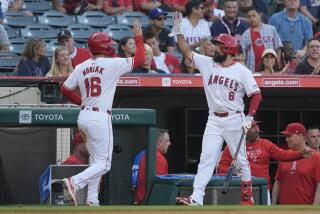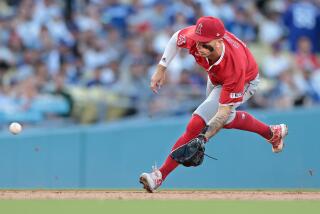Angels’ Infield-on-the-Fly Rules
- Share via
There was “Angels in the Outfield,” a bad Disney movie about a team inspired by arm-flapping fans, and now there is Angels in the Infield, a real-life story about a World Series-bound Angel quartet that seems to have been spliced together in a studio editing room.
When the Angels oppose the San Francisco Giants in Game 1 Saturday night, they will have a third baseman playing first base, a shortstop playing second, a second baseman playing shortstop and a shortstop playing third.
Confused? So were Angel infielders at times last season, when their inexperience at certain positions led to some rough-around-the-edges play and some doubts as to whether the moves would stick in the long run.
But with another full season in their respective spots, first baseman Scott Spiezio, second baseman Adam Kennedy, shortstop David Eckstein and third baseman Troy Glaus have jelled into a superb infield; the Angels had the American League’s second-best fielding percentage (.986) this season and committed the second-fewest errors (87).
“It’s a game of adjustments,” Eckstein said, “and I guess we just kept adjusting.”
No one more so than Eckstein, the 5-foot-7, 170-pound bundle of energy who is the smallest of the group but was the biggest risk in the Angels’ musical-chairs-like infield alignment.
Eckstein, who played second for four years in Boston’s farm system before being claimed off waivers by the Angels on Aug. 16, 2000, opened the 2001 season as the Angel second baseman while Kennedy recovered from a spring-training hand injury.
Eckstein so impressed the Angels with his offensive spark, defensive intuition and gritty play that the team had to find a spot for him when Kennedy returned. But when first base coach Alfredo Griffin suggested shortstop, Manager Mike Scioscia looked at Griffin as if he had two heads.
“I said, ‘Are you kidding me?’ ” Scioscia said. “But from the first game he played shortstop for us early last year, he hasn’t looked back. He’s been incredible.”
During the division series in New York, Yankee fans serenaded Eckstein with chants of “Little Leaguer, Little Leaguer,” and not just because of his size. To compensate for his below-average arm, Eckstein uses baseball’s most exaggerated crow hop--it’s more of a hop, skip and a jump--before heaving the ball across the infield.
“I hate watching myself throw, and my older brother [Rick] always got mad at me for throwing that way, but that’s the only way I know how to do it,” said Eckstein, whose 14 errors were sixth-fewest among AL shortstops. “I take my crow hop, jump, run across the field and throw it. It’s not normal, but I find a way to get it done.”
So has the other half of the Angel double-play combination, though not without some growing pains. Kennedy played shortstop in high school, college and in the St. Louis farm system before being traded to the Angels with pitcher Kent Bottenfield for center fielder Jim Edmonds on March 23, 2000.
The Angels moved Kennedy to second base, and the initial transition was about as smooth as a grounder in a rock-filled sandlot.
“The ball came at me from a totally different angle than I was used to my whole life, and I wasn’t used to the runners bearing down on me on double plays,” Kennedy said. “But I started to iron all those things out this year with the help of Alfredo.”
Almost every day during spring training, for 20 minutes after the regular workouts, Griffin took Kennedy and Eckstein to the lower fields at the Angels’ Tempe Diablo Stadium complex to work on double-play pivots and feeds. Kennedy, who made 11 errors this season, grew more comfortable and confident than he was in 2001.
“His general around-the-bag awareness needed work, from tagging runners out to turning double plays to his footwork,” bench coach Joe Maddon said. “He and Alfredo worked so hard in spring training, to the point where he’s now one of the better second basemen in the league.”
Glaus is one of the better third basemen in the league, but he played shortstop in high school and at UCLA.
Moving Glaus, the third overall pick in the 1997 draft, to third was a no-brainer--with his 6-foot-5, 245-pound frame, few thought he’d have the range or quickness to play shortstop in the big leagues, but his strong arm, soft hands and agility, honed during his years at shortstop, have served him well at third base.
Glaus still has a knack for making sensational plays while botching an occasional routine play, but he has lowered his error total from 33 in 2000 to 19 in 2001 and 20 this season.
Those figures, as well as the error totals for Kennedy and Eckstein, might have been higher if not for Spiezio, who has evolved from a utility player to a Gold Glove-caliber first baseman.
Spiezio, who played third base in the minor leagues, was so desperate to become a big league regular that when Oakland Manager Art Howe asked him in 1999 if he had ever played second base, Spiezio said, “Oh, yeah,” even though he hadn’t played a lick of second.
But the Spiezio-to-second experiment didn’t work for the A’s, who allowed Spiezio to leave as a free agent after 1999, or the Angels, who traded for Kennedy when it was apparent Spiezio couldn’t play second in the spring of 2000.
First base, though, was a different story. Spiezio replaced the injured Mo Vaughn at first for most of 2001, showing occasional flashes of brilliance, and his three errors this season were the fewest among AL first basemen. “He’s definitely the reason this has worked, he’s the catalyst,” Kennedy said. “You don’t have to worry about throwing a strike, just field it and get it to an area where he can catch it.”
The infield might not win any Gold Glove awards or dominate the TV highlights, but it’s more than adequate in the field.
“It’s not about making the extraordinary play, it’s about make the boring play,” Maddon said. “To be a very good defense, you have to make the boring play, and our guys are very boring on defense.”
More to Read
Go beyond the scoreboard
Get the latest on L.A.'s teams in the daily Sports Report newsletter.
You may occasionally receive promotional content from the Los Angeles Times.







